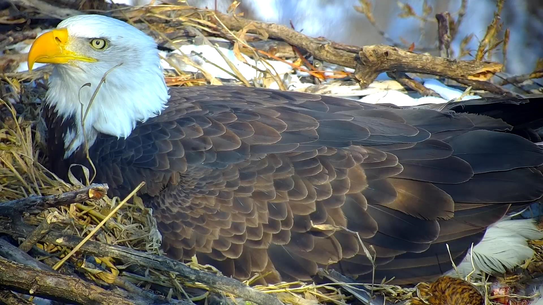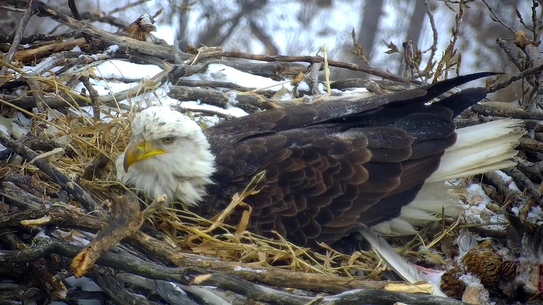|
March 5, 2021
 Our resident female incubating.
 The young dad incubating
The count-down has begun!
The first egg arrived in our eagle nest on February 15, and the second and final egg was laid on February 20 - over 90 hours between the two eggs! The length of time between the two eggs being laid is quite long, though it's still within normal range for eagles. Now that it has been more than a week, we know there will not be a third egg. The average clutch size for eagles is 1-3. It is the first time we've had only two eggs; every other successful clutch at this nest has had three eggs. It is possible that young eagles produce fewer eggs to ensure the success of the chicks. We are very fortunate to have eggs at all this year, as our male is young (approaching 5 years old), and this is likely his first nesting attempt. Many eagle pairs often don't produce eggs or young their first year as a mated pair. Having only two mouths to feed should be easier for the new pair to manage.
During incubation, the female sits on the eggs most of the time, but the male also helps. They make sure the eggs are protected from the weather, and they roll them around to keep all parts of the egg at the same temperature and to prevent the developing embryo inside the egg from sticking to the egg shell. Both parents are vigilant in protecting the eggs from predators or intruders. Our young male is proving to be a good protector of the nest and the eggs. He will need to learn how to bring food into the nest for the female, as well as two chicks when they come. This will determine how successful the hatch will be.
Don't be alarmed if the eggs are left uncovered for a short while. It's normal, even in cold weather for the parents to lightly cover the eggs with grasses and leave temporarily. Unless the egg is left for hours at this "delayed incubation" stage, the egg will not freeze and should hatch without any trouble. Get ready to see those cute bobble-heads in about 35 days, around March 23. The first chick will be days ahead of the second one, since each egg needs at least 35 days to incubate. This will give the older one an advantage, but both chicks should be able to thrive with only two mouths to be fed.
Watching the EagleCam is both educational and fun. But there's lots going on outdoors this time of year, too.
Listen for coyotes howling in the evening as they seek mates. Hawks also begin their mating season this time of year, complete with acrobatic flights, dives, and piercing screams. Migrating birds return to fill the air with their calls. As ice leaves the St. Croix, Mississippi and other rivers, you may see large numbers of waterfowl. Afton State Park offers some great eagle watching opportunities in the Spring, as does Frontenac State Park between Red Wing and Lake City. Some birds that stick around all winter begin to change their tune when Spring is in the air. The northern cardinal, for instance, switches to a more elongated whistling song in March to establish its territory and attract a partner.
Old-timers say that when the cardinal and the chickadee start singing their Spring songs, it’s time to tap trees for maple syrup. The same springtime freeze-thaw cycle that gives rise to potholes in Minnesota roads causes the sap to flow in the maple trees, providing the raw material that can be boiled down into tasty maple syrup. Squirrels know all about that. You can often see them on a warm March day gnawing around buds or broken branches to get at the sweet sap. In March, they need the extra calories, because they may be caring for a nest of youngsters.
This update, the EagleCam itself, and a host of other Nongame Wildlife Program efforts to sustain Minnesota's wildlife diversity is only possible because of the donations and support of people like you. Thanks so much!
The female sits on the nest. Is she wondering what we're all looking at?
|